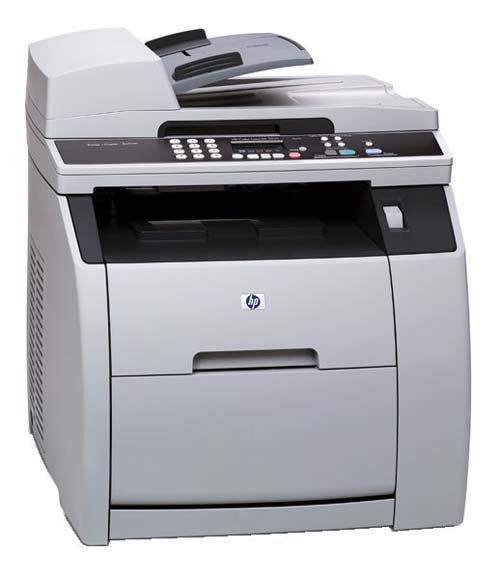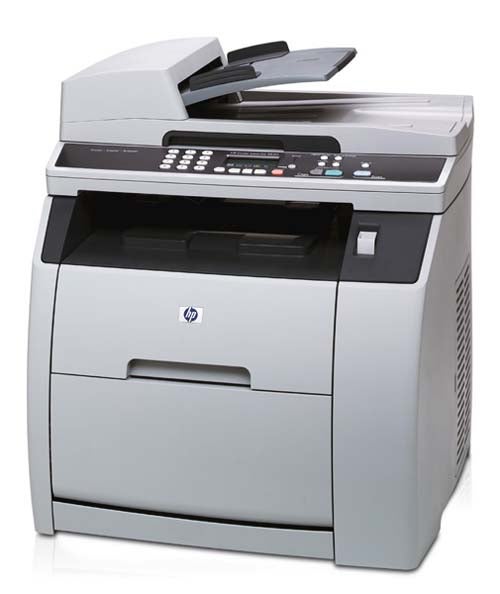HP Color LaserJet 2820 – Multi Function Device Review
HP Color LaserJet 2820 – Multi Function Device
Just like Epson, hp is dipping its toe in the waters of colour laser based multi-function devices. But how does this new hp model compare to the excellent Epson?

Verdict
Key Specifications
- Review Price: £548.00
HP has just introduced a new category of multifunction printer, the Color LaserJet 2800 series, of which the 2820 is the entry-level offering. This is a printer-copier-scanner device, based not on an ink-jet printer, but on HP’s colour laser engine, as used in the popular 2550 series of printers.
When we recently reviewed Epson’s first attempt at a colour laser multifunction machine, we were surprised that it did not include a multi-purpose feed tray. We can’t level that criticism at the Color LaserJet 2820, as it has a 125-sheet multi-purpose tray, but that’s all it has. The 250-sheet, Tray 2 is an optional extra, so you have to keep the printer front open with the multi-purpose tray unfolded all the time you’re using the machine. This is a recipe for people to come along and knock the paper out of the tray – especially in cramped, small offices.
Otherwise, the device is well designed, with a tighter fit between printer and scanner than some of its competitors. It looks more like a purpose-built, integrated device than the product of a designer with a jig-saw and a bottle of super glue.
The control panel is well organised, with coloured buttons to distinguish between functions and a two line, back-lit display which offers useful advice and messages and shows the status of the four toner cartridges.

The flatbed scanner is fitted with a 50-sheet auto-document feeder as standard and is easy to set up and use for copying or scanning directly to a local or networked PC. The 2820 comes with 10/100 Ethernet built in, as well as a USB 2.0 port.
The photoconductor unit and toner cartridges fit easily through a cover in the front of the machine. A scanner section unlocks and hinges up out of the way and there’s a useful carousel rotate button on the control panel, which makes servicing toner straightforward. The printer section of the machine uses this carousel of four toners to keep the overall size down.
The Windows software installation is long-winded, though not complicated and the finished suite includes a copy of the Read IRIS Pro OCR application, as well as a comprehensive set of printer control software. The driver includes most of the usual options, including watermarks and multiple pages per sheet, but there’s no automatic duplex facility.
One of the first things you notice when you run print tests on this machine is the amount of noise it makes. Not only is it loud – we measured it at peaks of nearly 65dBA – but the tone of the noises is also obtrusive. If it were a washing machine, we’d be wanting to get a service agent out.
There were two things to note from our speed tests. First, the machine is not that fast. The five page text test took 56 seconds to complete, with the colour text and graphics print taking 36 seconds. The 3 x 5in photo print took 42 seconds and a colour copy completed in 38 seconds. Compare those times with the Epson machine, which took 23 seconds, 18 seconds, 19 seconds and 29 seconds, respectively, almost twice as fast in every case.
The other problem was a print error in one of the test pieces. This piece includes a multicoloured headline, produced using Word’s WordArt applet. We’ve used this piece as one of our test samples for the last two years and have never had it printed incorrectly. Here though, the HP machine printed blocks of colour behind each of the text characters in the headline, rather than printing coloured characters. Looks like a software driver glitch to us.

Against this, the colour output from the machine is generally superb. We really are getting somewhere near ink-jet output quality, certainly on plain paper. Our test photo image was vivid and unblemished, with no noticeable banding and, of course, the permanence of dry toner printing.
The printer section of the colour LaserJet 2820 uses two types of consumable: a photo conductor unit and four colour toner cartridges. There are standard (2,000 pages at five per cent cover) and high yield (4,000 pages) versions of the cyan, magenta and yellow toner cartridges. As usual, we used the high yield versions to obtain the best cost figures. The photo conductor unit is rated at 20,000 pages, but this drops to 5,000 pages when you’re printing in colour.
Overall running costs work out at 1.89p per black page and 7.46p full-colour. Both these figures are slightly better than the Epson equivalents, but will depend on where you source your consumables from. These were the best prices we could find at the time of writing.
”’Verdict”’
The concept of the Color LaserJet 2820 is good and the physical implementation is neat and effective. The print speed leaves a lot to be desired, though, the noises it makes are unpleasant and we were surprised to see a corruption in one of our print samples. Perhaps you’re better off waiting for the second generation model.
(table:features)
(table:running)
Trusted Score
Score in detail
-
Print Speed 5
-
Features 6
-
Value 7
-
Print Quality 8
Features
| Networking | Fast Ethernet |
Printing
| Duplex | Manual |
| Paper Size | Letter, Executive, Legal, Envelope No. 10, Monarch Envelope, Custom Size |
| Sheet Capacity | 125 sheets |
| Rated Black Speed (Images per minute) | 20 ppmipm |
| Rated Colour Speed (Images per minute) | 4 ppmipm |
Scanning
| Scan Resolution (Dots per inch) | 1200 dpi |

